James Dorr's Blog, page 139
September 4, 2016
Bloomington Arts Fair, Writers Guild Spoken Word Stage Highlight Labor Day Weekend
From the essay on poetry I mentioned writing two posts below: . . . when I was much younger, poets sometimes read poems with jazz in the background. A muted piano, stand-up bass, a drummer for accents with cymbals and brush, an alto sax, maybe, while the poet recited the words over it, not as lyrics, but for their own sake, the musicians having the job to make sure their own sounds worked with them. So Saturday showed the art may not be lost completely. Saturday I had other work downtown as well (well, on Sunday too) but, when I had a chance, I kept coming back to the Spoken Word Stage. And one half hour slot had been taken by a group called “Shakespeare’s Monkey,” billed as a “poetry band,” and, yes, there was a poet reading and accompanied by music. The mix was different — two guitars and percussion, the last sometimes switching off to kazoo-like muted horn sounds, even “echos” of parts of one poem’s words, the modes were different, traditional jazz-like 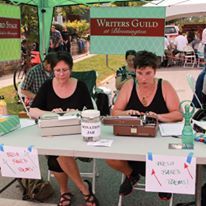 for one poem about “surrealism,” more strictly rhythmic for a poem that had come before, but the principle was the same, and the sound of the poems with musicians sharing them was delightful.
for one poem about “surrealism,” more strictly rhythmic for a poem that had come before, but the principle was the same, and the sound of the poems with musicians sharing them was delightful.
The event is Bloomington’s annual Fourth Street Festival of the Arts and Crafts (to give it its full, official name), with artists’ booths up and down 4th Street and parts of the cross streets, drawing in artists across the Midwest and beyond. In conjunction with this, the Spoken Word Stage is co-sponsored by the Bloomington Writers Guild, taking up Dunn Street south of 4th, with an information and “Poetry on Demand” booth (the latter where people can have personal poems written for them by Guild members, in exchange for hoped for donations) as well as the stage. And, while most of Saturday’s readers were poets, there was a children’s theater and, later, a radio theater group too. As well, of the poets, both the present and a past Indiana Poet Laureate.
Sunday, by contrast, brought fiction too, two slots billed as “fiction,” three “storytelling,” and one “horror fiction.” Guess which one was mine! These in all cases were half-hour readings, with eight more (one billed as including “personal essay”) taken up by poets. Mine was relatively late in the day, from 3:30 to 4 p.m., out of prime time but not so late that, on a beautiful sunny day, people would have been leaving already. The piece I read was a story called “Raising the Dead,” originally published in AIRSHIPS & AUTOMATONS (White Cat Publications, 2015 — cf. May 27 2015, et al.) and to be in the final section, of five and an entr’acte, in TOMBS: A CHRONICLE OF LATTER-DAY TIMES OF EARTH, to be published next year.
All in all a good time, for more of which (the Writers Guild part anyway) one may press here.


September 3, 2016
Cemetery Riots Celebrates Start of September; It’s About Time Galley Received
It was delayed a couple of months, but, originally listed as published in June, CEMETERY RIOTS (see July 6, et al.) has made its mailbox debut today. It looks worth the wait too, a handsome volume and with an A-list of writers adorning the contents — among whom, it would appear, is me. The cover’s subtitle is “A Collection of Dark 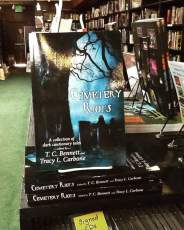 Cautionary Tales” and, true to this promise, my entry is “The Re-Possessed” in which it is found it is not a good thing to stiff (to pardon the expression) an undertaker with friends in the right places. If you haven’t gotten a copy of CEMETERY RIOTS already, more information can be found here.
Cautionary Tales” and, true to this promise, my entry is “The Re-Possessed” in which it is found it is not a good thing to stiff (to pardon the expression) an undertaker with friends in the right places. If you haven’t gotten a copy of CEMETERY RIOTS already, more information can be found here.
Today was also the first day of the weekend’s local arts fair, of which the Bloomington Writers Guild’s Spoken Word Stage is a part, and in which I will have a reading Sunday, but more on that later. For today’s, or more properly late yesterday’s contribution to The Writing Life we will go instead to Main Street Rag Publishing which, after a brief false start (an attachment sent for a different book), has sent galleys to proofread for IT’S ABOUT TIME (cf. August 12, June 29, et al.), though I may not get to them till Monday, Labor Day. My story in this one is a reprint, originally published in THE FICTION PRIMER, December 1988, about a man who discovers his true love in (ahem!) a timely fashion. For more information on this one press here.


August 31, 2016
The Death of Poetry? (And then, Speaking of Poems. . . .)
Well, no, or at least I don’t expect such demise is absolutely nigh. But it is true that really long poems (think Wordsworth, for instance, and poems like “The Prelude” or Byron’s “Childe Harold’s Pilgrimage” that go on for pages and pages) are rarer these days than a century or two back. (Never read either? I rest my case.) Not that they aren’t being written at all, but. . . .
And yesterday I finished and submitted an essay, somewhat on request, to answer the question of why new generations don’t seem to appreciate poetry even as much as we do now. What can we do to tempt them to read it and, hopefully, thus immersed discover for themselves its joys. What do we as readers and writers find that attracts us? (More on this later, the essay that is, if it is accepted — if not, you didn’t hear about it here either.)
Well of course there’s TV, and video games, and all sorts of distractions. I in my essay discuss poems as music, but then can the printed (or even pixeled) page compete with concert footage on MTV? For that matter, do we (in general) appreciate music as much as, say, people in Mozart’s time did?
But to stick to writing, can it be that we ourselves are changing? Being spoiled perhaps by technology, but paying a price without even knowing it, part of which may be a dulling to things like poetry. And so came today, via BIGTHINK.COM, an article by Philip Perry, “Cognitive Offloading: How the Internet is Changing the Human Brain.”
To pull out two paragraphs: We know for a fact computers are rewiring our brains. One study using brain imaging technology showed that receiving reminders for an event actually changed activity inside the brain. Though cognitive changes are occurring, most of us aren’t aware of them. That’s not the case for Atlantic writer Nicholas Carr. He says he notices it when reading. Carr writes about this in his article, “Is Google Making us Stupid?” which was developed into a book, The Shallows: What the Internet Is Doing to Our Brains. Carr does credit the internet for making research that used to take days available in mere minutes. But what we get comes at a cost. Carr believes focus and deep contemplation are what we are giving up. Furthermore, we may be better at multitasking, but creativity could be suffering.
Several other writers mentioned in the piece say that they used to be voracious book readers, yet cannot seem to focus and follow along anymore, preferring to do all of their reading online instead. Today, people may be reading more than decades ago. But according to Maryanne Wolf, a developmental psychologist at Tufts University, we read differently. We skim, wanting immediate information but missing deeper context, varying interpretations, and some of the richer portions of the reading experience.
May it be, then, that no matter what essays are written by we poets, no matter how tasty the bait we dangle, it will not be taken? To  read more, press here.
read more, press here.
And, speaking of poems, as of August 30 it seems I’ve had 236 of them published in various magazines and books. It’s actually more, since the figure doesn’t count ones in VAMPS or in my long out of print chapbook TOWERS OF DARKNESS that haven’t also been published separately elsewhere (though it does count a few published on this blog only). Also the figure for prose short fiction and novelettes comes to 271 (with possibly one or two stand alone story chapbooks omitted), for a total of 507 individual publications. And this is original publications; a number of these have since been reprinted, some several times, as well as re-appeared in collections, but reprints don’t get any extra credit.
And so what, anyway? Well, for the last few years I’ve been dutifully sending out my bio with submissions, containing a line that, in addition to various books, I’ve had “nearly 400 individual appearances from ALFRED HITCHCOCK’S MYSTERY MAGAZINE to YELLOW BAT REVIEW.” Sometimes I substitute XENOPHILIA for the latter title, but the implication is still from “A to Z” (though ABORIGINAL SCIENCE FICTION precedes ALFRED HITCHCOCK’S) and from high circulation and well known to the small and relatively obscure. For some time, though, I’d been putting off the task of actually counting them since whenever the last time was, but in an idle moment last night I thought, “Why not?” It was just before bedtime and beat counting sheep.
So for whoever cares, it looks like I’ll have to change that line to “more than 500.”


August 29, 2016
Great Tome of Fantastic and Wondrous Places Ready for Kindle Pre-Order
Just a quick note, that Volume 3 in Bards and Sages GREAT TOMES series, THE GREAT TOME OF FANTASTIC AND WONDROUS PLACES has been posted by Amazon for pre-order in its Kindle edition. Print, presumably, will follow. My journey in this juxtaposition is a dark Russian fantas y set in the early Twentieth Century, “Ice Vermin,” originally published in CD ROM in EXTREMES 5 (Lone Wolf Publications, 2003) and in print in my second collection, DARKER LOVES: TALES OF MYSTERY AND REGRET (Dark Regions Press, 2007). Ah, but with one difference, this being the “scholarly edition” where editor’s notes within the text in the original version have been replaced by end notes, thus separating, in a sense, the narrative into two separate stories.
y set in the early Twentieth Century, “Ice Vermin,” originally published in CD ROM in EXTREMES 5 (Lone Wolf Publications, 2003) and in print in my second collection, DARKER LOVES: TALES OF MYSTERY AND REGRET (Dark Regions Press, 2007). Ah, but with one difference, this being the “scholarly edition” where editor’s notes within the text in the original version have been replaced by end notes, thus separating, in a sense, the narrative into two separate stories.
So you, the reader, thus have a choice — you can look up the end notes as you come to them, thus replicating the original version, or wait until you get to the end and read them in one lump, solving perhaps some mysteries that came up along the way. In either case, though, for more information, one may press here.


August 28, 2016
Last Sunday Poets (and a Tiny Lagniappe)
As fall creeps forward, despite a hot, humid, and sunny day, this afternoon marked the 2016-17 season opening “Last Sunday Poetry Reading,” sponsored by the Bloomington Writers Guild in conjunction with the Monroe County Convention Center (for its “First Sunday” prose analogue, see below, August 8). But this year’s started a little differently, one of two scheduled poets down with the flu, plus the convention center also hosting the Indiana Toy and Comic Expo (so that’s why those people were out in the hall wearing Imperial Storm Trooper armor! Also the R2D2 upstairs). So, while the crowd wasn’t the largest it’s ever been either, that just meant more time for the Open Mike after.
The reader who was here was Andrew Hubbard, originally from New England but now a Monroe County resident, with two poetry books published by Interactive Press in Australia, the second, THE DIVINING ROD, having come out just last week. Hubbard started by saying he’d been reading contemporary poetry that seemed overly angry to his taste, but he would begin with a happier poem. Those that followed also were generally low key, personal poems, with a quiet optimism, involving such things as “The Last Butterfly,” a rescued turtle, deer in the garden, and the poet’s daughter. Hubbard also, I understand, will be a reader at “First Sunday Prose” in October, sharing the podium with local mostly-poet Margaret Squires and . . . me (with, in my case, most likely another tale from the upcoming TOMBS: A CHRONICLE OF LATTER-DAY TIMES OF EARTH, cf. August 18, 14, 8, et al.).
Then came the unscheduled readers, including Patsy Rahn who had warned me that she would premiere a poem inspired (sort of) by me, “A Vision for James Dorr,” a poem of bones, constructions, and science fiction. As luck would have it, the next poet was me, so I started by saying it would be amusing if I now read poems about puppies and kittens, and then recited a cat haiku from memory which I’ll repeat here*:
slinking cat’s wet cough
presages hairball, but where?
foot put in shoe knows
But, anyway, I followed that with three poems on the more mundane topic of vampires, all unpublished (just written last May), “Running Its Course,” “The Vampire’s Reminder,” and “Time-Stop,” the last an impressionistic recall of a vamp’s first blood dinner.
.
*The poem originally was titled “WHOOPS!” (as a lookup after the fact reveals to me) and published in HAZARD CAT on August 24 2010, and appears below as a lagniappe too on March 15 2011, but why not repeat it anyway, eh? Also, following my reading, Tonia Matthews read, among other poems, an account of taking her cat to the vet.


August 27, 2016
Nine Must Read (or Reread) Stories to Help You Prepare for Halloween
Is the cusp of autumn on us already? Tuesday, ending music practice, we noticed that it was already twilight — how many more weeks until twilight comes at the beginning of practice? Then today at the market, after the first Writers Guild meeting following its annual summer hiatus, I saw — and bought — a half gallon of “Pumpkin Pie” ice c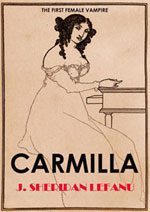 ream, a specialty flavor not usually available until close to Thanksgiving. And this, on Facebook this afternoon via Robert Dunbar and LITERARY DARKNESS, in turn via HORROR NOVEL REVIEWS, a link to THEWEEK.COM and “9 Classic Horror Stories You Can Read Right Now” by Scott Meslow, “[f]rom Washington Irving to H.P. Lovecraft, a collection of terrifying tales to get you into the Halloween spirit.” This, yes, another list, but with each description and opening sample a separate link to read the whole story there on the spot. Long ones such as “Carmilla” and “The Turn of the Screw,” and shorter ones by Lovecaft as well, and Blackwood and Poe, and maybe even a surprise or two.
ream, a specialty flavor not usually available until close to Thanksgiving. And this, on Facebook this afternoon via Robert Dunbar and LITERARY DARKNESS, in turn via HORROR NOVEL REVIEWS, a link to THEWEEK.COM and “9 Classic Horror Stories You Can Read Right Now” by Scott Meslow, “[f]rom Washington Irving to H.P. Lovecraft, a collection of terrifying tales to get you into the Halloween spirit.” This, yes, another list, but with each description and opening sample a separate link to read the whole story there on the spot. Long ones such as “Carmilla” and “The Turn of the Screw,” and shorter ones by Lovecaft as well, and Blackwood and Poe, and maybe even a surprise or two.
To see — and read — for yourself, press here.


August 26, 2016
First Things First, or, The Beginning of the World
Yes, that’s right, the origin of everything with today’s discovery via the internet by Edira Putri, “The Weirdest Creation Myths from Religions Around the World” on RANKER.COM, with bringing-to-my-attention credit going to Gene Stewart. So getting right to it (to quote Ms. Putri): Some people turn to scientific efforts to explain why and how the universe is the way it is.  Others prefer transcendental beings, gods, or rituals. Aside from being spiritual, the cultures that birthed these weird religious creation myths were also highly creative. Who would have thought butter could form the world? How did you link the origin of existence with extraterrestrial realms? How could creation stories link us to monsters, giants, even bugs?
Others prefer transcendental beings, gods, or rituals. Aside from being spiritual, the cultures that birthed these weird religious creation myths were also highly creative. Who would have thought butter could form the world? How did you link the origin of existence with extraterrestrial realms? How could creation stories link us to monsters, giants, even bugs?
These weird creation myths around the world, promoted by religions, may be easier to pass on and to learn than scientific theories, and only seem truly bizarre when held in relief against modern scientific knowledge. Basically, we think we know better now. But do we?
There are fourteen myths recounted in all, some ancient, some more modern, which can be seen here (I’m partial to number 3 myself). Which one is your favorite?


August 23, 2016
Killer Kudzu Comes to Local Indiana Mailbox
“Yes, we’ve been at this for twenty years now!
“Ten years ago we published FLUSH FICTION, VOLUME I: STORIES TO BE READ IN ONE SITTING. Now, only ten years later, we’re doing it again. Once again these amazing writers are saying it in — well, most of them in less than a thousand words!”
Such is the blurb for FLUSH FICTION II: TWENTY YEARS OF LETTING IT GO (cf. May 21, March 27), which arrived in my mailbox today. Edited by Selina Rosen, this celebrates 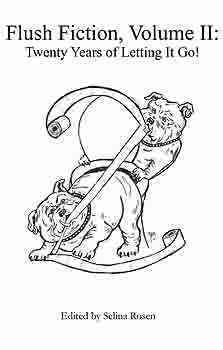 twenty years of publishing by Yard Dog Press in the press’s charmingly unpretentious way. In fact, two other posts here can be found on August 1 2013 and April 8 2011, or thereabouts, noting not just the first FLUSH FICTION but their BUBBAS OF THE APOCALYPSE series, in which I have stories in four of five volumes, as well.
twenty years of publishing by Yard Dog Press in the press’s charmingly unpretentious way. In fact, two other posts here can be found on August 1 2013 and April 8 2011, or thereabouts, noting not just the first FLUSH FICTION but their BUBBAS OF THE APOCALYPSE series, in which I have stories in four of five volumes, as well.
My entry in this one, published in June, is called “Killer Kudzu,” a tale of horticulture gone bad in the American South. And without a happy ending either, but perhaps shocking enough to scare the. . . . Well you get the idea, and to see for yourself (plus explore around to see more of the Arkansas ambience of Yard Dog Press) as well as perhaps buy a copy press here.


August 22, 2016
Wizard’s Way: Misfit Stories Galley Received
“Can a poor farmer get justice in a court of law when an errant wizard destroys his crops? And even if the crime can be proven and restitution ordered, how does one compel a wizard to comply?” This the blurb, or at least a preliminary version, by Bards and Sages Publishing for my story “By Force and Against the King’s Peace,” currently scheduled for September 9 for THE SOCIETY OF MISFIT STORIES (see July 6, June 23). This is a new electronic-only publication, tailored for stories from about 5,000 to 20,000 words, “to provide a loving home for those misfit tales that are too long for most periodicals but too short for print.” And so today the galley proof came with a request for it to be returned by the weekend with any changes. Yes, the life of the writer continues.
“By Force and Against the King’s Peace” has been published before, in ALFRED HITCHCOCK’S MYSTERY MAGAZINE in December 1999, and, yes, partly because of its relatively long length (about 9800 words), it has not been reprinted since. Also it is a story of crime, though speculative too as defined by Bards and Sages’s guidelines (“horror, science fiction, slipstream, steampunk, magical realism, etc.”), a sort of fantasy courtroom drama involving a young, new-minted wizard just starting her practice and an experienced, older — but not too old — King’s Justice of the Peace.
And, of course, magic.


August 21, 2016
At the Movies: A Mini-Look at Franco’s Dracula, plus a Footnote on Christopher Lee
I watched Jess Franco’s 1970 COUNT DRACULA last night and, as Dracula movies go, I thought it pretty good despite some critics’ claim that the film moves too slowly in places. Of course Soledad Miranda in the part of Lucy didn’t hurt either, but Franco himself in an interview in the DVD’s “extras” makes a good case comparing it to other films, notably Francis Ford Coppola’s DRACULA (depicting Dracula as being in love is untrue to the vampire myth as seen by Bram Stoker) and the various Hammer versions (they tend not to take the material as seriously as they should), while at the same time admiring the original 1931 film with Bela Lugosi. Franco’s also follows the novel fairly closely, 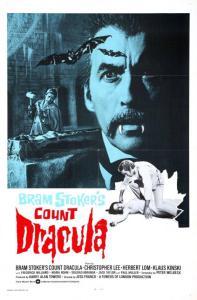 compared to others, though there are still some simplifications (Dr. Seward works in van Helsing’s sanatorium; Quincy as a British Baronet is Lucy’s sole suitor, e.g.), and also stars Christopher Lee* in the title role as well as Klaus Kinski as Renfield. And there are a few glitches, as in the sanatorium where Lucy and Mina will stay for a few nights, even though a servant had been told specifically to find rooms for them on the ground floor (the upper floors being where patients are housed), when the bat flies by to entice Lucy out, she goes down a long staircase to get to the door outside.
compared to others, though there are still some simplifications (Dr. Seward works in van Helsing’s sanatorium; Quincy as a British Baronet is Lucy’s sole suitor, e.g.), and also stars Christopher Lee* in the title role as well as Klaus Kinski as Renfield. And there are a few glitches, as in the sanatorium where Lucy and Mina will stay for a few nights, even though a servant had been told specifically to find rooms for them on the ground floor (the upper floors being where patients are housed), when the bat flies by to entice Lucy out, she goes down a long staircase to get to the door outside.
So is it worth seeing? Yes. The photography’s good, I thought, and it follows the story closely and cleanly for the most part, in itself refreshing. And Christopher Lee’s role is terrific, playing on the idea from Stoker that, as the vampire drinks more blood there’s also a rejuvenation process, thus Lee’s character becomes younger looking as the film progresses. The ending, to be sure, is jazzed up then by the process reversing, the corpse-to-be getting rapidly older until reduced to a skeleton and/or dust, a vampire cliche (but also true to the novel) shared with lesser movies too, but what the heck, it’s to be expected. And here, from the novel, we’re given a reason, and that’s worth something!
.
*Of course, Christopher Lee starred in all those Hammer Films too. And so I blundered onto an interesting appreciation of all (or mostly so) nine of the films he made playing Dracula on BLASTR.COM, even if compiler Dany Roth ranked COUNT DRACULA as only number four, which can be found here. And even Roth had a good word to say for the appearance of the three “brides” of Dracula in Franco’s version.





